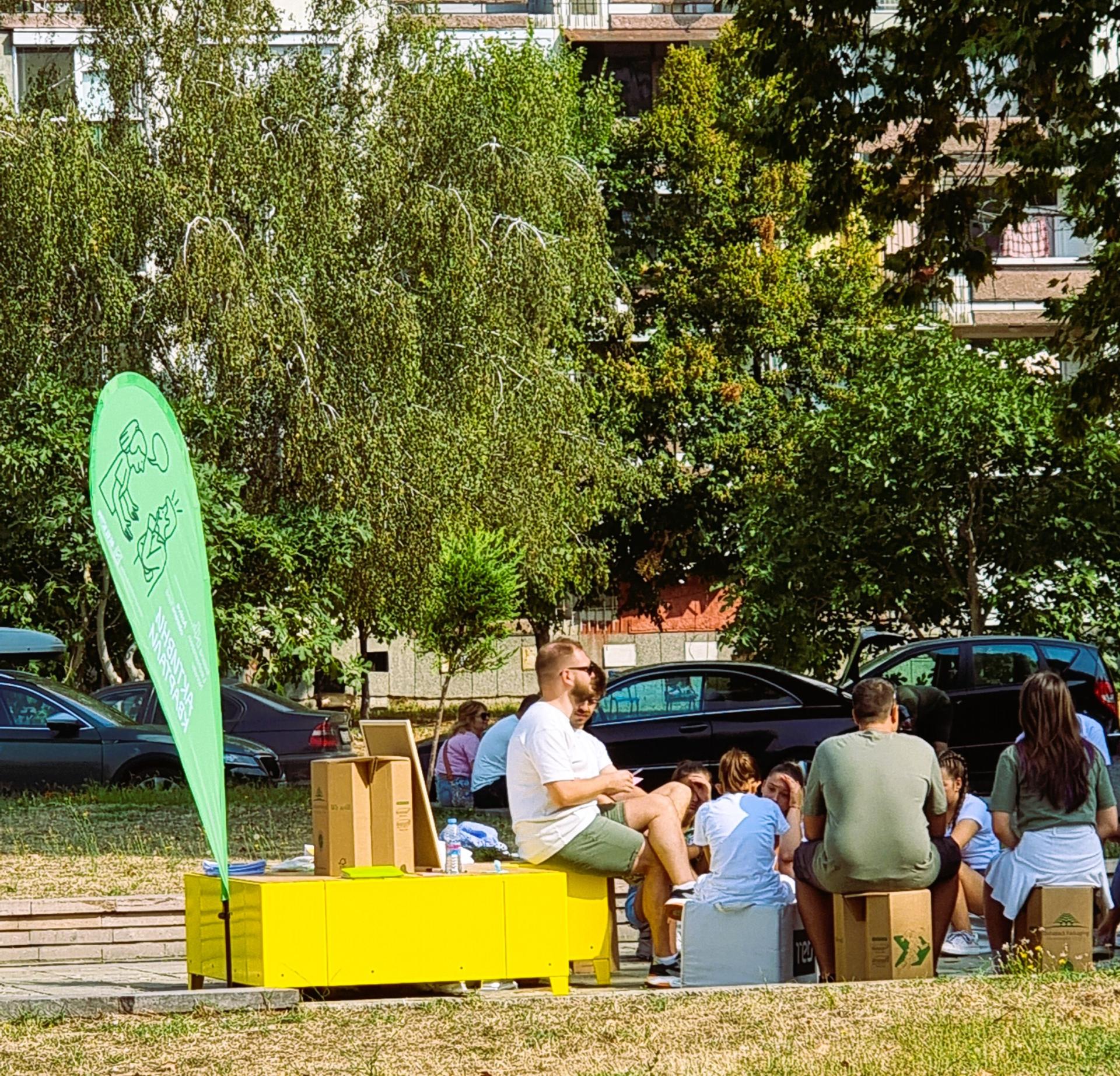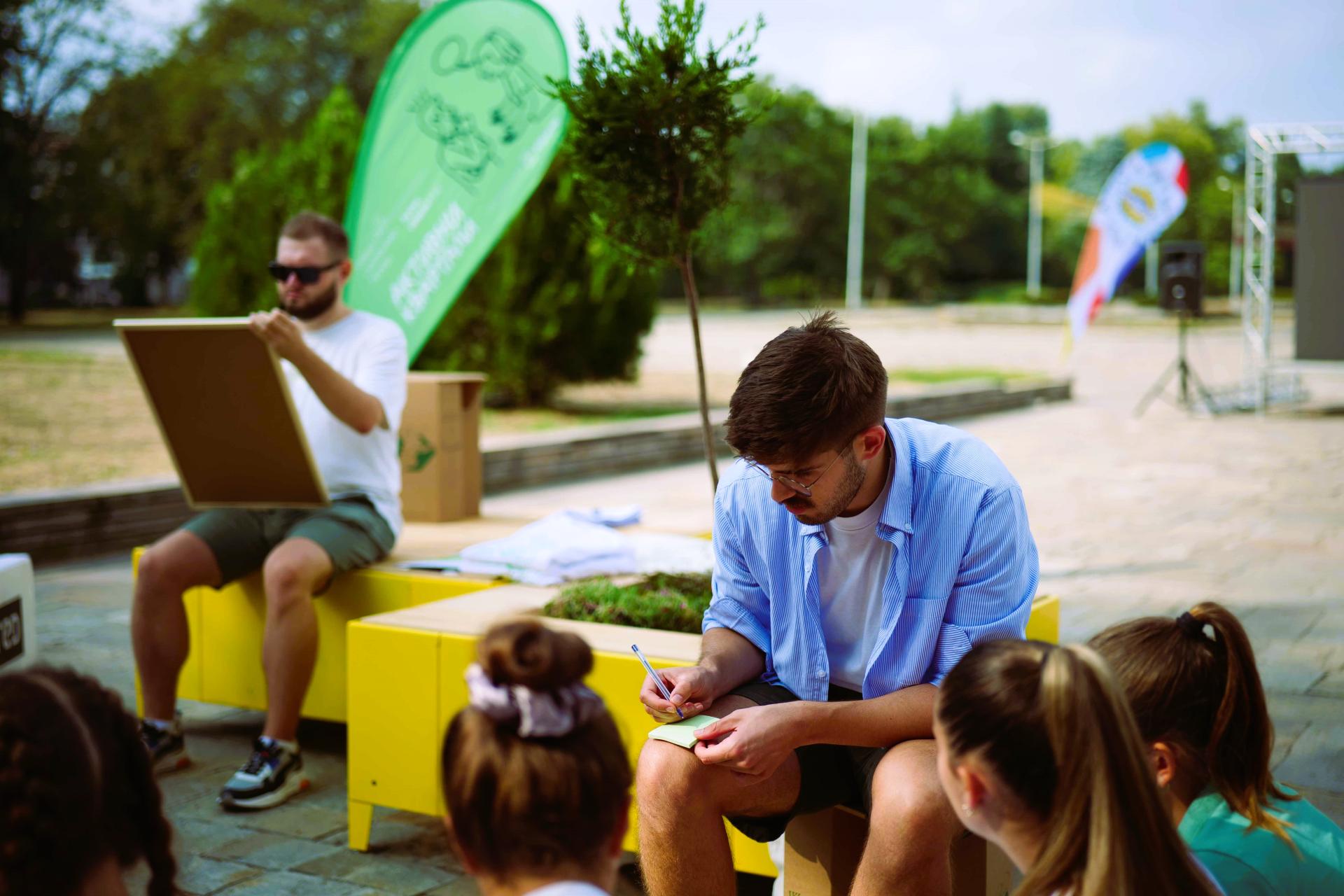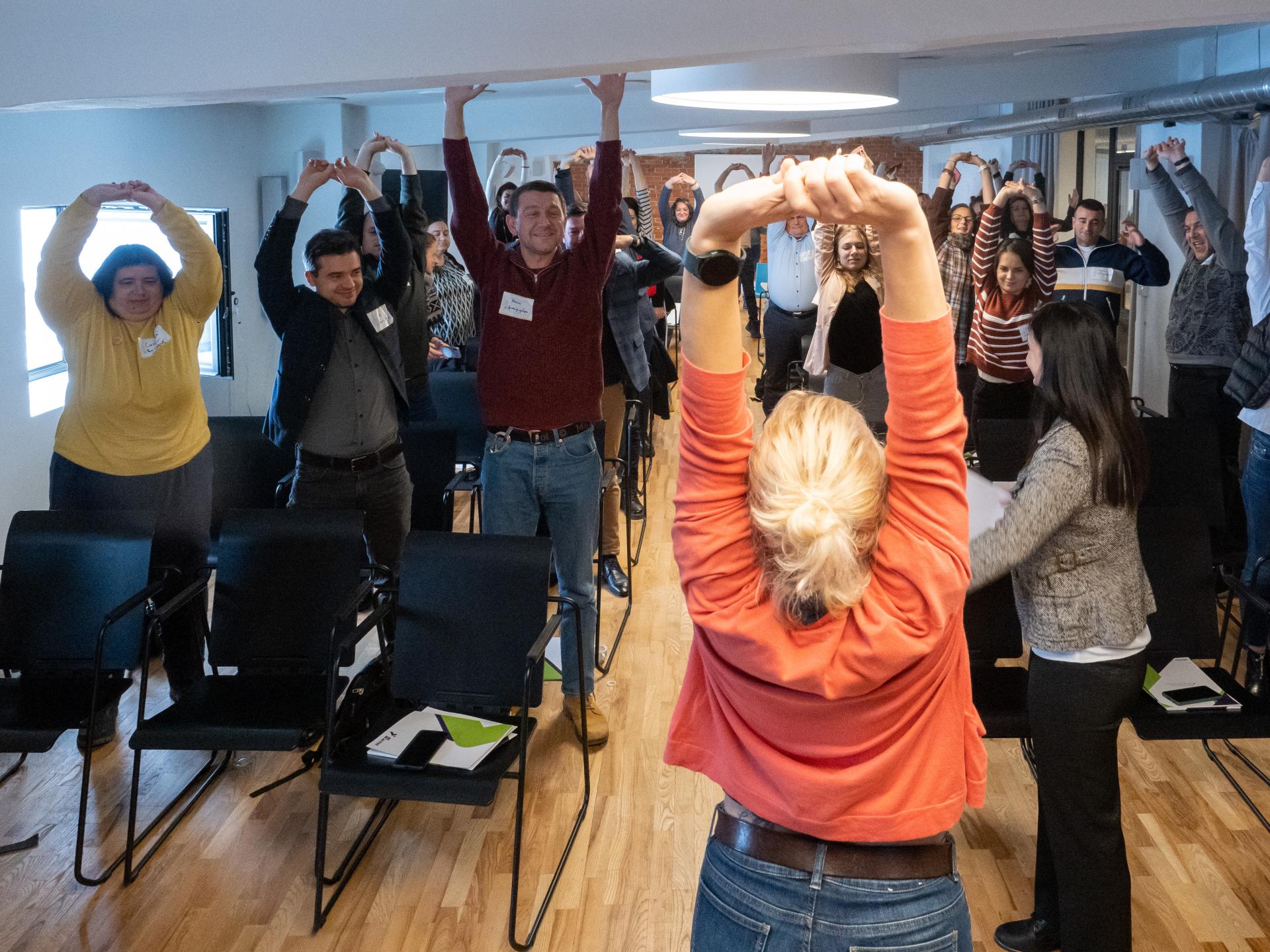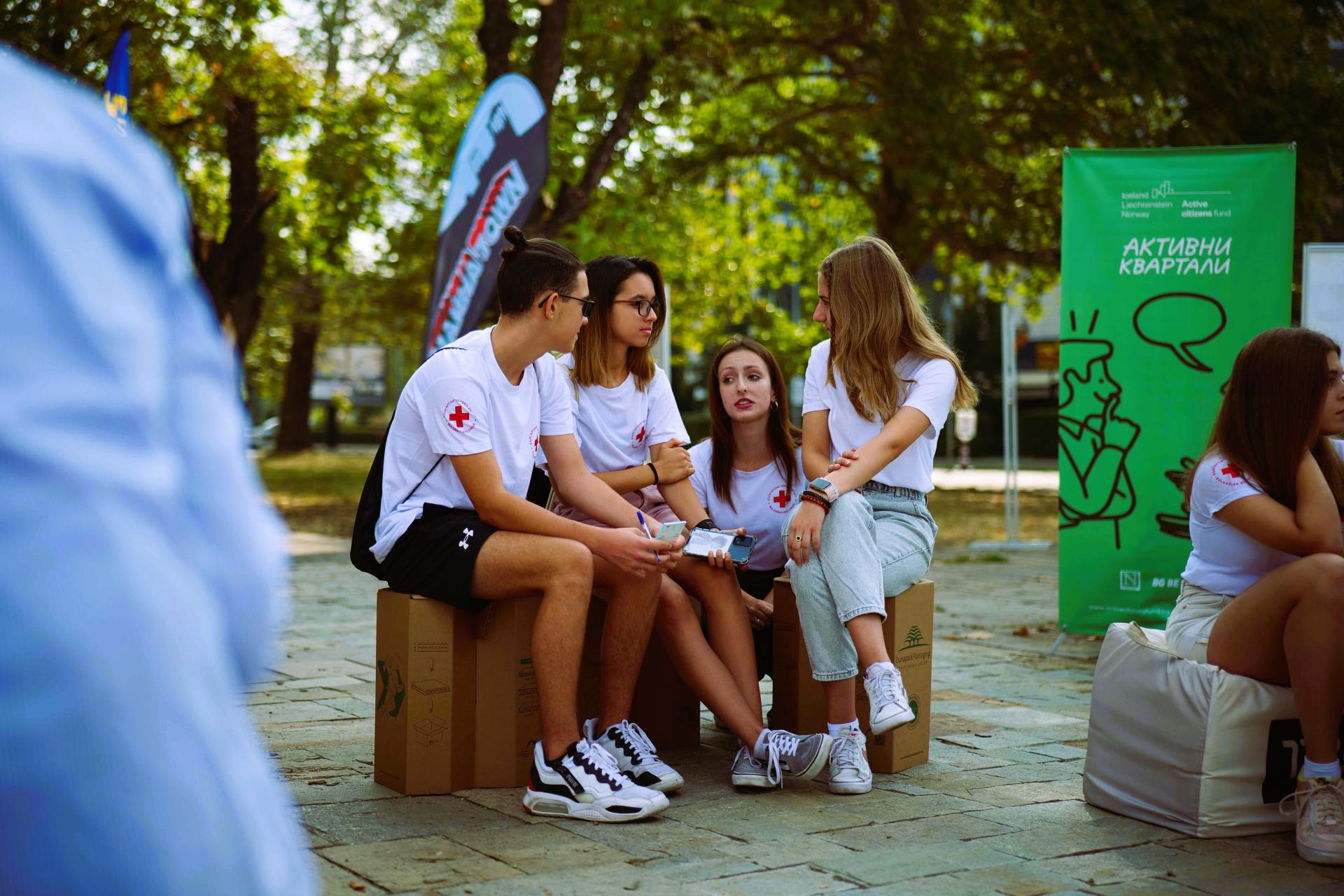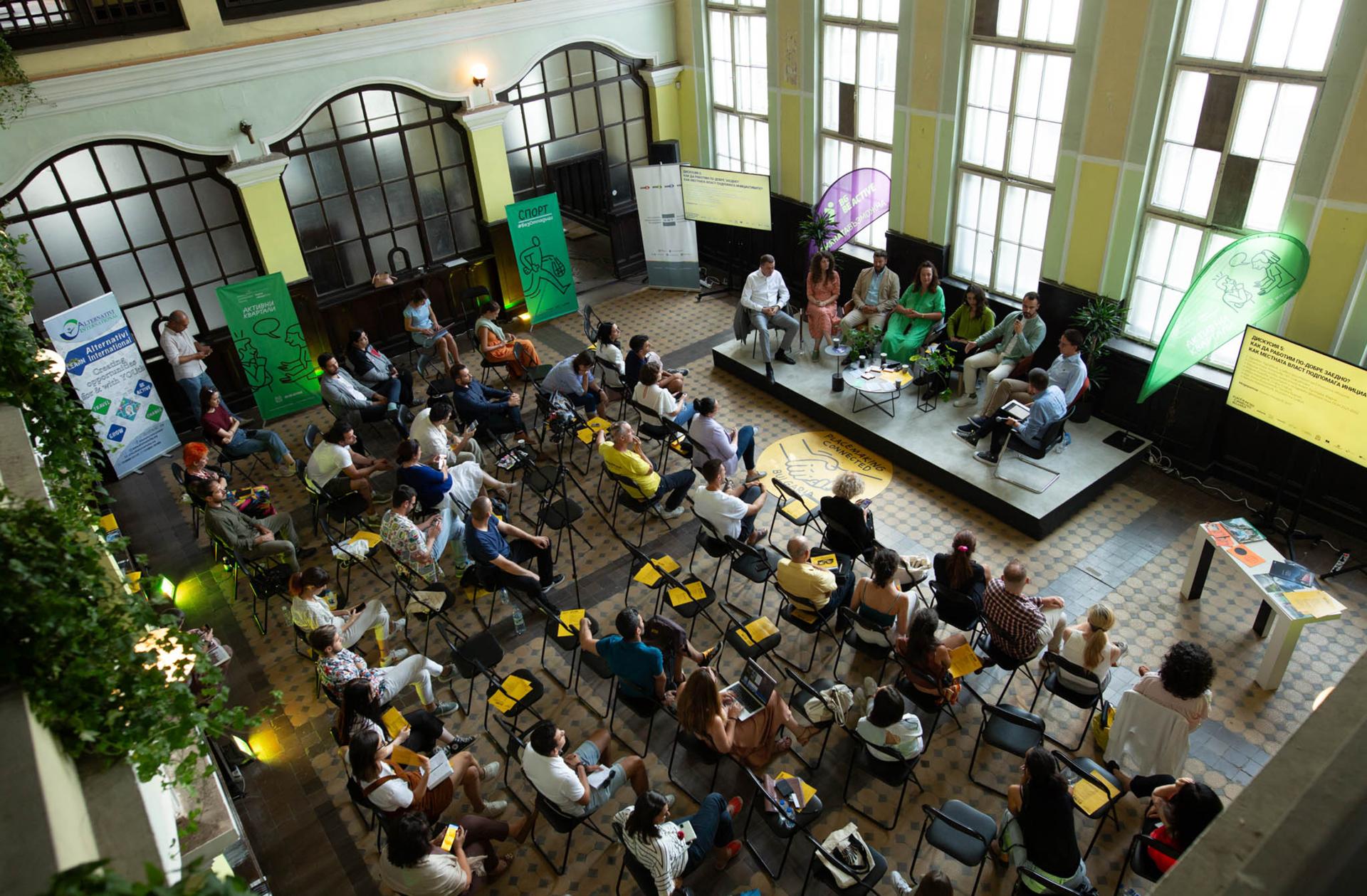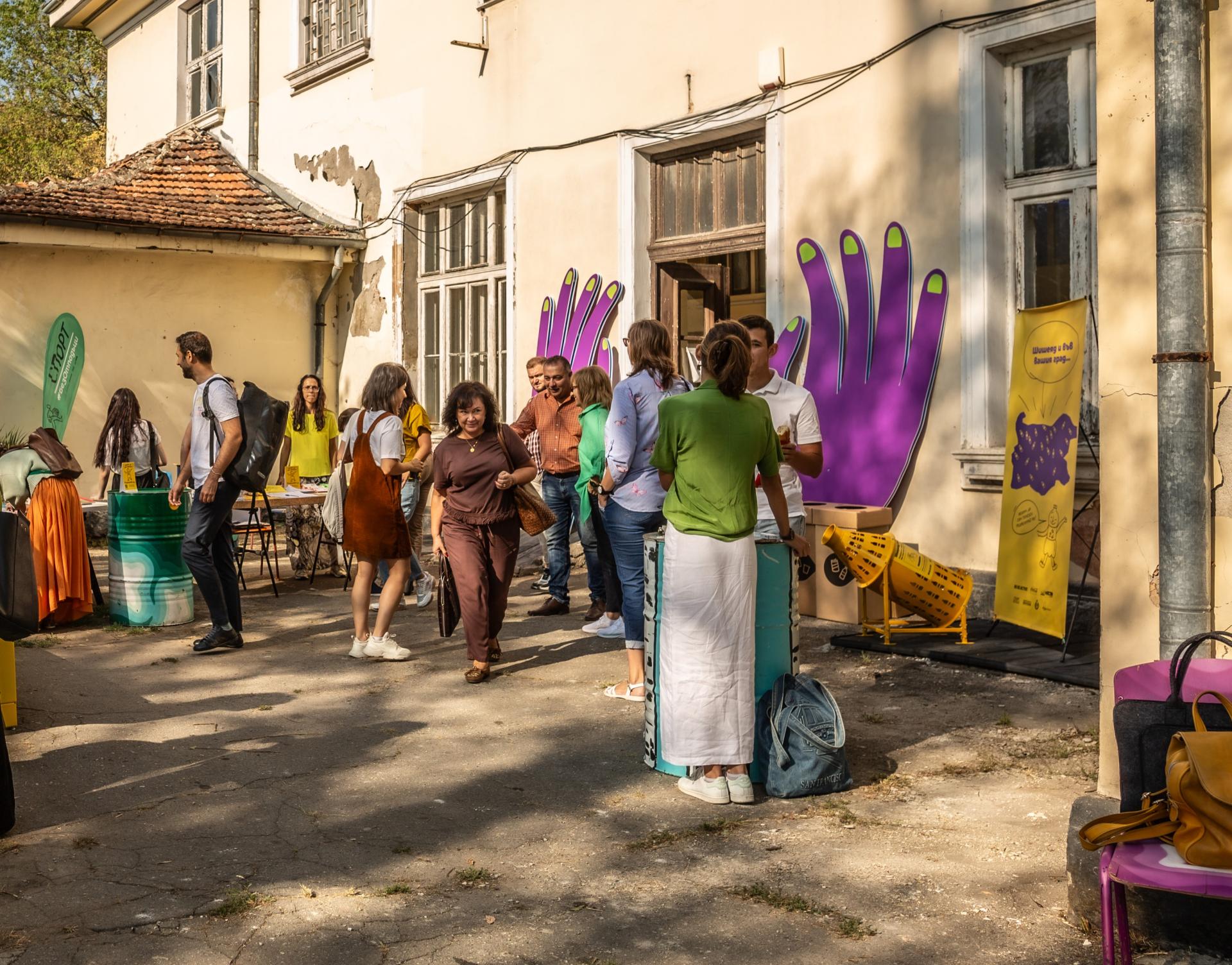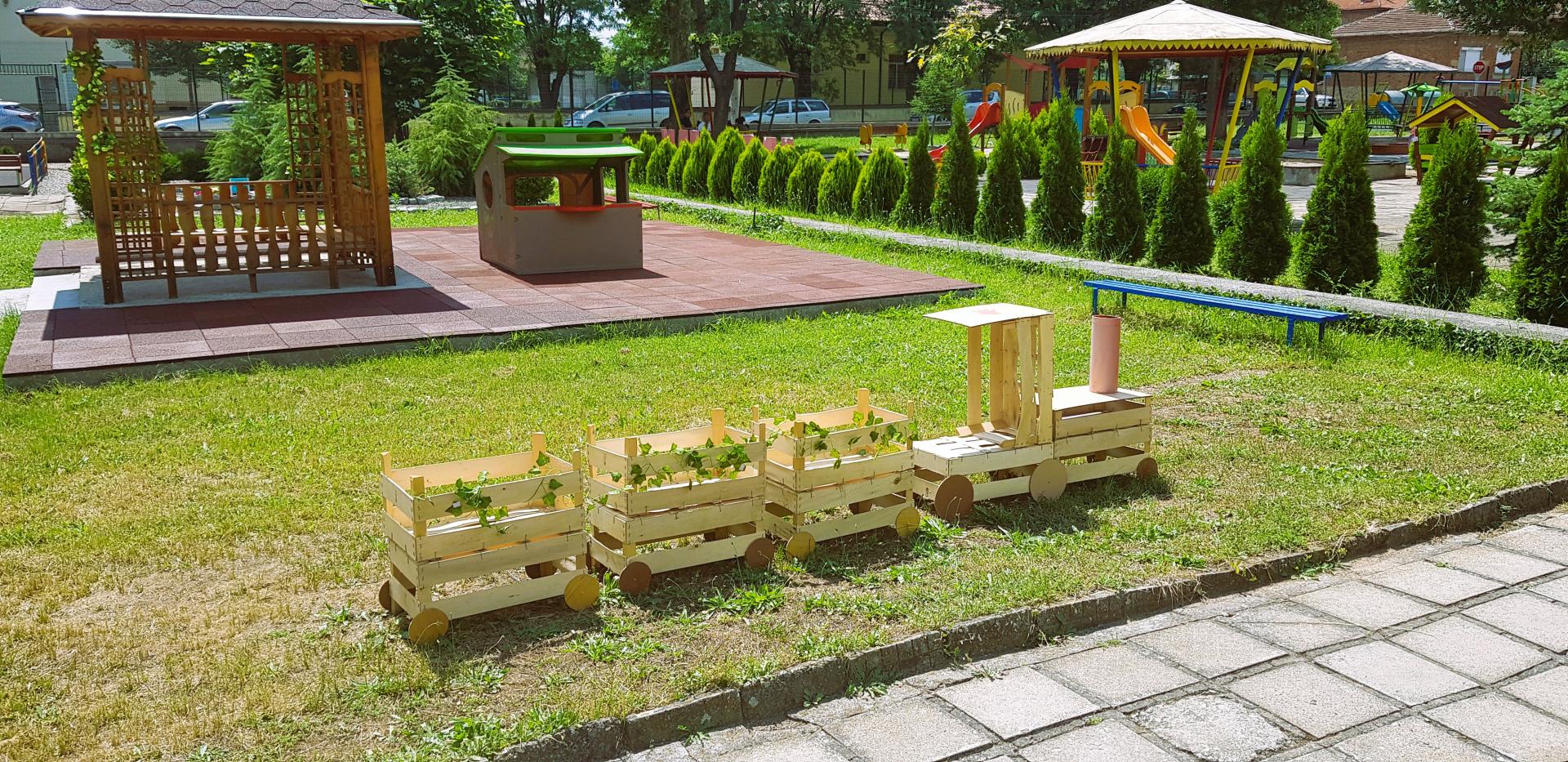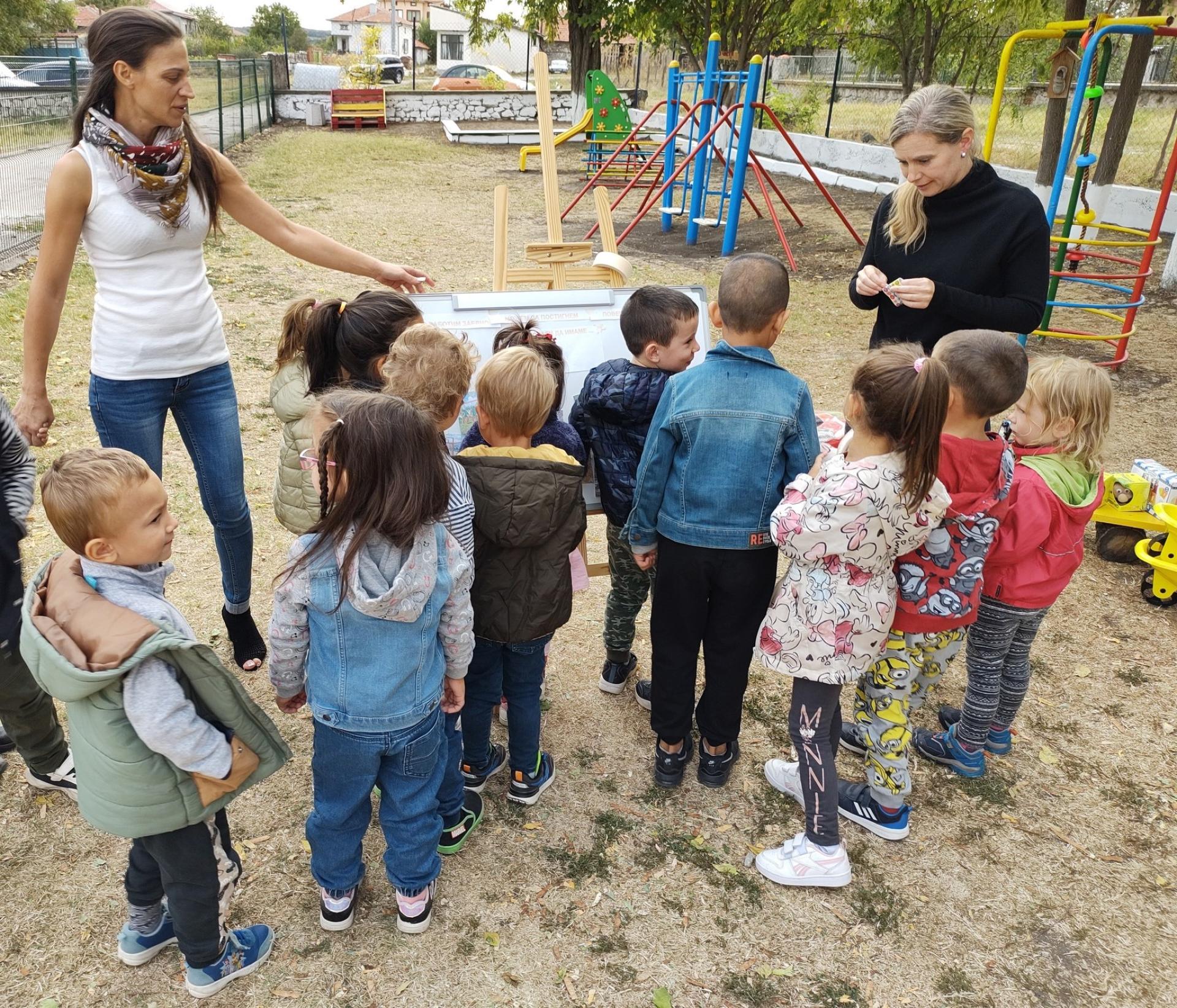Active Neighbourhoods
Basic information
Project Title
Active Neighbourhoods
Full project title
Neighbourhood Democracy in Urban Communities
Category
Prioritising the places and people that need it the most
Project Description
Initiated as a response to post-communist community rehabilitation in Bulgaria, “Active Neighbourhoods” aims to enhance civic space in Bulgaria’s urban communities through democratic participation in the development of beautiful, sustainable and inclusive public spaces and promotion of local policies in public administrations. With local residents' involvement at its core, the initiative addresses the global challenge of democratic decline.
Geographical Scope
National
Project Region
Bulgaria
Urban or rural issues
Mainly urban
Physical or other transformations
It refers to other types of transformations (soft investment)
EU Programme or fund
No
Description of the project
Summary
“Active Neighbourhoods” (АN) initiative aims to enhance civic space in Bulgaria’s urban communities through democratic participation in the development of beautiful, sustainable and inclusive public spaces, the concept of placemaking and the promotion of local community policies in public administrations. The initiative targets civic organisations, public institutions (at a national and local level), and local communities.
In essence, “AN” aims (1) to help municipalities better understand the importance of civic participation in decision-making, (2) to help citizens build necessary "soft" habits and understand principles in accessible language before engaging in a placemaking process, and accordingly placemaking is more open, and (3) to strengthen the role of civil organizations as mediators in the process.
The specific objectives of the initiative:
- To lay the foundations for a democratic dialogue between civic organisations/activists and municipalities through establishing relevant resource base and research
- To boost neighborhood democracy in local communities through the pilot test activities involving local forums and placemaking interventions
- To inspire citizens to participate in the political processes at a local level by capacitating the relevant stakeholders on their roles.
The key outcomes of the initiative:
- Research of public spaces with over 100 successful placemaking stories across Bulgaria and comparative analysis with the Norwegian context
- 5 capacity-building activities for the civic activists and organizations on civic engagement in public spaces
- 8 pilot test activities in 4 locations in Bulgaria, involving a civic forum and placemaking intervention each
- 4 structured dialogues on the local level with representatives of local municipalities
In essence, “AN” aims (1) to help municipalities better understand the importance of civic participation in decision-making, (2) to help citizens build necessary "soft" habits and understand principles in accessible language before engaging in a placemaking process, and accordingly placemaking is more open, and (3) to strengthen the role of civil organizations as mediators in the process.
The specific objectives of the initiative:
- To lay the foundations for a democratic dialogue between civic organisations/activists and municipalities through establishing relevant resource base and research
- To boost neighborhood democracy in local communities through the pilot test activities involving local forums and placemaking interventions
- To inspire citizens to participate in the political processes at a local level by capacitating the relevant stakeholders on their roles.
The key outcomes of the initiative:
- Research of public spaces with over 100 successful placemaking stories across Bulgaria and comparative analysis with the Norwegian context
- 5 capacity-building activities for the civic activists and organizations on civic engagement in public spaces
- 8 pilot test activities in 4 locations in Bulgaria, involving a civic forum and placemaking intervention each
- 4 structured dialogues on the local level with representatives of local municipalities
Key objectives for sustainability
The "Active Neighbourhoods" (AN) objectives in terms of sustainability were:
1. Prolongation of Usability. AN methodology is focused to the sustainable development of public spaces.
2. To approach the process holistically considering the environmental, social, and economic systems aiming for a balance that supported the entire ecosystem.
3. To ensure that the placemaking interventions are designed to regenerate and enhance the natural environment within urban settings.
Achievements in sustainability:
• Our research into placemaking practices included an analysis of how these spaces could contribute to a sustainable urban ecosystem, respecting both social needs and environmental boundaries.
• Through capacity-building activities, we empowered civic activists and organizations with the skills to create and maintain sustainable public spaces.
• Our pilot activities demonstrated how local forums and interventions could serve as models for sustainable community development, with the potential to regenerate urban ecosystems.
• The dialogues we facilitated focused on integrating sustainability into local governance, encouraging policies that prioritized people’s needs in small villages, rural areas and degenerated city districts.
• Engaging citizens in the placemaking process, AN promoted a sustainable lifestyle that valued community, connection to nature, and responsible stewardship of shared spaces.
"AN" exemplified sustainability by fostering a regenerative approach that reconnected communities with nature, embodying sustainability values—impacting lifestyles, relations, and the economy.
1. Prolongation of Usability. AN methodology is focused to the sustainable development of public spaces.
2. To approach the process holistically considering the environmental, social, and economic systems aiming for a balance that supported the entire ecosystem.
3. To ensure that the placemaking interventions are designed to regenerate and enhance the natural environment within urban settings.
Achievements in sustainability:
• Our research into placemaking practices included an analysis of how these spaces could contribute to a sustainable urban ecosystem, respecting both social needs and environmental boundaries.
• Through capacity-building activities, we empowered civic activists and organizations with the skills to create and maintain sustainable public spaces.
• Our pilot activities demonstrated how local forums and interventions could serve as models for sustainable community development, with the potential to regenerate urban ecosystems.
• The dialogues we facilitated focused on integrating sustainability into local governance, encouraging policies that prioritized people’s needs in small villages, rural areas and degenerated city districts.
• Engaging citizens in the placemaking process, AN promoted a sustainable lifestyle that valued community, connection to nature, and responsible stewardship of shared spaces.
"AN" exemplified sustainability by fostering a regenerative approach that reconnected communities with nature, embodying sustainability values—impacting lifestyles, relations, and the economy.
Key objectives for aesthetics and quality
With the fact that most of the communities in Bulgaria lack successful stories of civic engagement, and community residents’ input is employed for tokenism and manipulation (especially at the times of elections), the key objective in terms of aesthetics and quality of experience for people is to foster sense of belonging through collective experience of democracy in a public space. Through implementing a community initiative, the residents needed to explain their ideas for a specific place, negotiate with community neighbors on the plan, compromise given the restricted funds, and work together to improve a place.
As a result of 8 interventions in 4 locations, the residents created spaces attentive to context (ensured through the collection of ideas among the residents) with mutual care (as a result of the collective community efforts), but most importantly they developed a sense of agency and relevant democratic skills to maintain their spaces through meaningful interactions and collective experiences. With the aim to boost bottom-up democracy, the initiative rests on the principle that politics should start locally: when people are encouraged to be involved in activities in the community that they are familiar with and that they care about, they will begin to feel more in control of their local environment– leading eventually to wider engagement, empowerment, and trust. The target groups from rural and city communities learnt the process from the practice of democratic skills.
The initiative is exemplary as it encourages relevant community processes and roles, gives first experience of positive engagement in civic initiatives, and supports local decision-making for all by engaging relevant stakeholders – civic activists, organisations and municipalities.
As a result of 8 interventions in 4 locations, the residents created spaces attentive to context (ensured through the collection of ideas among the residents) with mutual care (as a result of the collective community efforts), but most importantly they developed a sense of agency and relevant democratic skills to maintain their spaces through meaningful interactions and collective experiences. With the aim to boost bottom-up democracy, the initiative rests on the principle that politics should start locally: when people are encouraged to be involved in activities in the community that they are familiar with and that they care about, they will begin to feel more in control of their local environment– leading eventually to wider engagement, empowerment, and trust. The target groups from rural and city communities learnt the process from the practice of democratic skills.
The initiative is exemplary as it encourages relevant community processes and roles, gives first experience of positive engagement in civic initiatives, and supports local decision-making for all by engaging relevant stakeholders – civic activists, organisations and municipalities.
Key objectives for inclusion
A. To boost neighborhood democracy in local communities by creating opportunities for local residents to practice civic skills, while creating inclusive spaces for their needs. The initiative has selected areas that need urgent attention to respond to the needs of their residents and counter isolation in public spaces.
After a capacity-building training, the expert team selected 8 pilot interventions for implementing small-scale community projects with a small funding. The interventions aimed to create open accessible spaces for the needs of communities:
- spaces for children by children (in rural areas of Harmanli, Stamboliyski and Novi Iskar the interventions engaged children in educational workshops to understand the principles of collective placemaking and to explore the children needs, at the second part children – with the help of parents and teachers – created their green spaces for outdoor activities, such as games, workshops etc.)
- space for needs of the disadvantaged (in Lyulin area in Sofia the intervention engaged visually impaired people to create safe and accessible space to socialize)
- spaces in cities (the interventions in Sofia, Plovdiv and Haskovo addressed degenerated city districts with lack of accessible green spaces through the involvement of local residents).
B. To establish a viable model of implementing community initiatives based on legal and practical sides of civic engagement. With community initiatives often organised ad hoc, the team has aimed to formalize the civic participation by creating a specific step-by-step sustainable process.
On the legal side, we have researched the legislation regulating civic participation for the initiatives in public spaces in Bulgaria. On the practical side, while these laws are difficult to navigate for community leaders without proper education, we have equipped local communities’ leaders with the skills how to implement placemaking civic initiatives with community peers and guides.
After a capacity-building training, the expert team selected 8 pilot interventions for implementing small-scale community projects with a small funding. The interventions aimed to create open accessible spaces for the needs of communities:
- spaces for children by children (in rural areas of Harmanli, Stamboliyski and Novi Iskar the interventions engaged children in educational workshops to understand the principles of collective placemaking and to explore the children needs, at the second part children – with the help of parents and teachers – created their green spaces for outdoor activities, such as games, workshops etc.)
- space for needs of the disadvantaged (in Lyulin area in Sofia the intervention engaged visually impaired people to create safe and accessible space to socialize)
- spaces in cities (the interventions in Sofia, Plovdiv and Haskovo addressed degenerated city districts with lack of accessible green spaces through the involvement of local residents).
B. To establish a viable model of implementing community initiatives based on legal and practical sides of civic engagement. With community initiatives often organised ad hoc, the team has aimed to formalize the civic participation by creating a specific step-by-step sustainable process.
On the legal side, we have researched the legislation regulating civic participation for the initiatives in public spaces in Bulgaria. On the practical side, while these laws are difficult to navigate for community leaders without proper education, we have equipped local communities’ leaders with the skills how to implement placemaking civic initiatives with community peers and guides.
Results in relation to category
The initiative has created a new methodology “placemaking for democracy” that on the one hand encourages local residents to learn to negotiate, search for a consensus, overcome ingrained community conflicts and act together as a common entity, and on the other hand helps municipalities to understand better the role of community in decision-making. With practical tools developed, the methodology provides clear guidelines and steps for an intervention applicable in any context. The concept carries on as part of the Placemaking Bulgaria network involving diverse stakeholders to boost community participation and environmental initiatives. At the annual meeting of the Active Citizens Fund Bulgaria, the initiative was commended as an innovative means of promoting civic engagement.
8 communities from 4 locations have undergone the “placemaking for democracy” process: small rural communities of Harmanli and Stambolisyski (aiming to create community spaces for kids with the support of non-formal groups), degenerated city districts (lack of accessible green and inclusive public spaces in Plovdiv and Haskovo with the involvement of civic organisations), Sofia communities (accessible spaces for kids in neglected area of Novi Iskar and for the visually impaired people in destitute area of Lyulin in contrast to vibrant and colorful spaces in the city centers created by a 2023 NEB award winner “100 chairs”). With the fact that most of the communities in Bulgaria lack successful stories of civic engagement and residents’ input is employed for tokenism and manipulation, these interventions have provided first positive experience and reinforced a sense of community while creating human-oriented spaces.
As part of the structured dialogues, the initiative has converged legal and practical paths of civic engagement and created relevant conversations on community role in decision-making. This will help signal the need for consistent changes to the status quo when required.
8 communities from 4 locations have undergone the “placemaking for democracy” process: small rural communities of Harmanli and Stambolisyski (aiming to create community spaces for kids with the support of non-formal groups), degenerated city districts (lack of accessible green and inclusive public spaces in Plovdiv and Haskovo with the involvement of civic organisations), Sofia communities (accessible spaces for kids in neglected area of Novi Iskar and for the visually impaired people in destitute area of Lyulin in contrast to vibrant and colorful spaces in the city centers created by a 2023 NEB award winner “100 chairs”). With the fact that most of the communities in Bulgaria lack successful stories of civic engagement and residents’ input is employed for tokenism and manipulation, these interventions have provided first positive experience and reinforced a sense of community while creating human-oriented spaces.
As part of the structured dialogues, the initiative has converged legal and practical paths of civic engagement and created relevant conversations on community role in decision-making. This will help signal the need for consistent changes to the status quo when required.
How Citizens benefit
With the overall aim to bring communities into local decision-making and capacitate them with democratic skills, the initiative has engaged local civic activists throughout the whole timeline.
We launched an open call for local civic activists from small villages, rural areas, and degenerated city districts to see the experience of the participants in community placemaking project and collect ideas for improving community spaces in their localities. The participants’ involvement helped shape the structure of the capacity-building activity to provide relevant knowledge and expertise to initiate community projects. The training aimed to explain principles of civic engagement, capacitate on types of involvement (based on ladder of participation) and encourage participants to be critical of the role they are assigned in community projects (whether initiated by organisations, corporate actors or municipalities). The training specified on three levels of engagement: passive engagement (manipulation), tokenism (consultation), and citizen power (delegated power).
Following the training, 8 pilot test locations with the need for urgent attention were selected for a funding based on the idea that had to be further developed with community residents. The initiative had direct involvement of local residents in creating the public spaces for their needs, as in the process they had to explain their ideas for a specific place, negotiate with community neighbors on the plan, compromise given the restricted funds, and work together to improve a place. This all encouraged them to learn to negotiate, search for a consensus, overcome ingrained community conflicts and act together. The process was moderated by a local community activist with support of a local civic organisation.
In structured dialogues, local residents shared their challenges in communication with municipalities, experiences in initiating community projects and learning to work with community peers together.
We launched an open call for local civic activists from small villages, rural areas, and degenerated city districts to see the experience of the participants in community placemaking project and collect ideas for improving community spaces in their localities. The participants’ involvement helped shape the structure of the capacity-building activity to provide relevant knowledge and expertise to initiate community projects. The training aimed to explain principles of civic engagement, capacitate on types of involvement (based on ladder of participation) and encourage participants to be critical of the role they are assigned in community projects (whether initiated by organisations, corporate actors or municipalities). The training specified on three levels of engagement: passive engagement (manipulation), tokenism (consultation), and citizen power (delegated power).
Following the training, 8 pilot test locations with the need for urgent attention were selected for a funding based on the idea that had to be further developed with community residents. The initiative had direct involvement of local residents in creating the public spaces for their needs, as in the process they had to explain their ideas for a specific place, negotiate with community neighbors on the plan, compromise given the restricted funds, and work together to improve a place. This all encouraged them to learn to negotiate, search for a consensus, overcome ingrained community conflicts and act together. The process was moderated by a local community activist with support of a local civic organisation.
In structured dialogues, local residents shared their challenges in communication with municipalities, experiences in initiating community projects and learning to work with community peers together.
Physical or other transformations
It refers to other types of transformations (soft investment)
Innovative character
Unlike conventional top-down urban development models, AN emphasized democratic participation, inviting civic organizations, local communities, and public institutions to collaboratively shape public spaces. This participatory model is a departure from the norm, fostering a sense of ownership, responsibility among citizens and beautiful, sustainable and inclusive spaces for all.
AN combined the concept of placemaking with the promotion of community-focused policies within public administrations. This bridged the gap between practical urban development and policy-making, ensuring that the initiative's outcomes were sustainable and supported by local governance structures.
The initiative's focus on empowering citizens and civic organizations through capacity-building activities provided the tools and knowledge necessary to sustainably manage and advocate for their public spaces. This approach to building 'soft' habits and understanding in accessible language is innovative in its method of fostering informed and engaged citizenry.
By boosting neighborhood democracy, AN took an innovative stance on the role of local governance in sustainability, advocating for a bottom-up approach to decision-making that is not commonly practiced in the field. The initiative serves to build new relationships between local actors, communities, municipalities and civic organisations will have more trust in each other that will feed into continuing active citizenship and decreased feelings of alienation and isolation from decision-making structures in their localities.
"AN" has demonstrated how democratic participation, integrated policy-making, capacity-building, research, pilot testing, and structured dialogues can collectively contribute to the sustainable transformation of public spaces.
AN combined the concept of placemaking with the promotion of community-focused policies within public administrations. This bridged the gap between practical urban development and policy-making, ensuring that the initiative's outcomes were sustainable and supported by local governance structures.
The initiative's focus on empowering citizens and civic organizations through capacity-building activities provided the tools and knowledge necessary to sustainably manage and advocate for their public spaces. This approach to building 'soft' habits and understanding in accessible language is innovative in its method of fostering informed and engaged citizenry.
By boosting neighborhood democracy, AN took an innovative stance on the role of local governance in sustainability, advocating for a bottom-up approach to decision-making that is not commonly practiced in the field. The initiative serves to build new relationships between local actors, communities, municipalities and civic organisations will have more trust in each other that will feed into continuing active citizenship and decreased feelings of alienation and isolation from decision-making structures in their localities.
"AN" has demonstrated how democratic participation, integrated policy-making, capacity-building, research, pilot testing, and structured dialogues can collectively contribute to the sustainable transformation of public spaces.
Disciplines/knowledge reflected
With a public space as a key element where democratic civic engagement takes place, the initiative aims to demonstrate the multi-faceted nature of civic interactions in a public space. This required participation of experts from other disciplines.
“AN” involved a variety of stakeholders from several disciplines to ensure the success of the initiative. In its core design, the project structure was planned with experts from Bulgaria and Norway in the fields of project management, community engagement, urbanism, informal education and communication. They joined the working team group for preparing the initiative to ensure the activities are accessible to a diverse public, consistent to produce long-term impact and localized to target the relevant community needs. The working team gathered for regular project meetings to discuss the results and updates throughout the whole timeline of the initiative.
In order to produce high quality results adapted to the Bulgarian context, the working team collaborated with professionals in other adjacent spheres, involving them to specific project activities. The research and capacity-building activities included experts in sociology and public administration – these experts provided a key input towards the legal practice of public engagement and explained how it is regulated in the context of Bulgaria. The structured dialogues included the professionals in a multitude of areas - environment, culture, law, public administration, arts, etc. Their engagement demonstrated how these sectors are intertwined in a public space and how they all benefit from consistent public participation.
“AN” involved a variety of stakeholders from several disciplines to ensure the success of the initiative. In its core design, the project structure was planned with experts from Bulgaria and Norway in the fields of project management, community engagement, urbanism, informal education and communication. They joined the working team group for preparing the initiative to ensure the activities are accessible to a diverse public, consistent to produce long-term impact and localized to target the relevant community needs. The working team gathered for regular project meetings to discuss the results and updates throughout the whole timeline of the initiative.
In order to produce high quality results adapted to the Bulgarian context, the working team collaborated with professionals in other adjacent spheres, involving them to specific project activities. The research and capacity-building activities included experts in sociology and public administration – these experts provided a key input towards the legal practice of public engagement and explained how it is regulated in the context of Bulgaria. The structured dialogues included the professionals in a multitude of areas - environment, culture, law, public administration, arts, etc. Their engagement demonstrated how these sectors are intertwined in a public space and how they all benefit from consistent public participation.
Methodology used
“AN” has employed placemaking methodology in the process, while working with stakeholders and communities to inspire people to collectively reimagine their public spaces and ensure the changes will remain sustainable. Combining the instruments of placemaking with democratic principles of participation, public diplomacy and political innovation, “AN” has reinforced the former with “ladder of participation” (by S. Arnstein) self-assessment tool to ensure that civic engagement is consistent and conscious. The self-assessment tool serves to determine at what level community engagement is – informative participation, consultation, or partnership.
Based on the theory of change, through the series of impact measurement processes in communities, the initiative proved placemaking can be a positive catalyst for active citizenship–not only at the local level where placemaking actions occur, but also at the wider societal level.
In addressing the initiative objectives, the methodology consists of several specific methods:
- Research activities have involved the instruments of desk research, community interviews with the stakeholders, and comparative methods on the concepts of community entrepreneurship, leaderships and sustainability.
- Pilot interventions have been shaped with the principles of placemaking: community discussions, participation, physical interventions and celebration of results.
- Structured dialogues have been designed with the EU instrument of structured dialogue, involving (1) clear identification of topics; (2) proper identification of stakeholders (those who are influenced by decisions taken); (3) facilitation of the discussions; (4) tangibility of the results.
Based on the theory of change, through the series of impact measurement processes in communities, the initiative proved placemaking can be a positive catalyst for active citizenship–not only at the local level where placemaking actions occur, but also at the wider societal level.
In addressing the initiative objectives, the methodology consists of several specific methods:
- Research activities have involved the instruments of desk research, community interviews with the stakeholders, and comparative methods on the concepts of community entrepreneurship, leaderships and sustainability.
- Pilot interventions have been shaped with the principles of placemaking: community discussions, participation, physical interventions and celebration of results.
- Structured dialogues have been designed with the EU instrument of structured dialogue, involving (1) clear identification of topics; (2) proper identification of stakeholders (those who are influenced by decisions taken); (3) facilitation of the discussions; (4) tangibility of the results.
How stakeholders are engaged
“AN” engaged stakeholders on various levels throughout the whole timeline:
- Research activities to define the key trends of civic participation in public spaces across Bulgaria has involved 100+ stakeholders from civic, corporate, and public sectors with their stories of community projects – challenges, learnings, and observations. These projects helped to determine key trends of civic engagement in Bulgaria, and to conduct comparative analysis with the Norwegian context with the support of local activists from Norway.
- Capacity-building activities identified local activists and engaged civic society activists and urban experts to support community building through local forums and interventions. The initiative involved local civic organisations from 4 locations (Haskovo - Halo Foundation, Sofia - Can You Foundation, Burgas - Burgas Likes Youth + Plovdiv) to empower them to use the placemaking concept for community initiatives. This allowed to extend the initiative geographically and engage communities facing diverse social challenges.
- Within 4 structured dialogues on local level (in Burgas, Haskovo, Plovdiv, and Sofia), a key focus was to engage civic sector and communities in a conversation with municipal representatives - 25+ stakeholders for each structured dialogue. Having the municipal representatives together with civic activists at the table permitted to discuss challenges in civic engagement from various perspectives and find localized solutions relevant for a specific community context.
- On the national level, “AN” has brought 120+ community activists, civic organisations, municipalities, national public authorities and media to support the establishment of the national placemaking network. The diversity of participants in the network ensured representation of different community contexts and professional disciplines to boost public participation in communities and promote environmental initiatives.
- Research activities to define the key trends of civic participation in public spaces across Bulgaria has involved 100+ stakeholders from civic, corporate, and public sectors with their stories of community projects – challenges, learnings, and observations. These projects helped to determine key trends of civic engagement in Bulgaria, and to conduct comparative analysis with the Norwegian context with the support of local activists from Norway.
- Capacity-building activities identified local activists and engaged civic society activists and urban experts to support community building through local forums and interventions. The initiative involved local civic organisations from 4 locations (Haskovo - Halo Foundation, Sofia - Can You Foundation, Burgas - Burgas Likes Youth + Plovdiv) to empower them to use the placemaking concept for community initiatives. This allowed to extend the initiative geographically and engage communities facing diverse social challenges.
- Within 4 structured dialogues on local level (in Burgas, Haskovo, Plovdiv, and Sofia), a key focus was to engage civic sector and communities in a conversation with municipal representatives - 25+ stakeholders for each structured dialogue. Having the municipal representatives together with civic activists at the table permitted to discuss challenges in civic engagement from various perspectives and find localized solutions relevant for a specific community context.
- On the national level, “AN” has brought 120+ community activists, civic organisations, municipalities, national public authorities and media to support the establishment of the national placemaking network. The diversity of participants in the network ensured representation of different community contexts and professional disciplines to boost public participation in communities and promote environmental initiatives.
Global challenges
With community involvement in the process of designing, planning and implementing local interventions in public spaces, the initiative addresses the global challenge of democratic decline. The project focuses on bottom-up democracy and rests on the principle that politics should start locally: when people are encouraged to be involved in activities in the community they care about, they feel more in control of their local environment– leading eventually to wider engagement, empowerment, and trust. This improves political culture and “de-elitisizes” decision-making processes.
Initiated as a response to post-communist community rehabilitation in Bulgaria with lack of small community initiatives to enable local residents’ voices and to influence democratic ‘micro-institutions’ (democratic skills, democratic processes etc..), the initiative situates placemaking as a part of efforts to enhance grassroots participation, community empowerment, and local voices in democratic dialogue with public actors. Through the instruments of impact measurement, the initiative has proved capable to empower community activists to understand and reach out to decision-makers in their local municipality. Despite conflicting opinions during the interventions, the participation is widely experienced as positive and trust-building.
The initiative presents an easy and accessible road map for community activists to organize local initiatives in public spaces, provides better understanding of stakeholders’ roles and explains the importance of community input at decision making. This helps to turn community activism into a steady action and encourage municipal employees “not to fear new ideas”. The initiative capacitates civic communities on how to make their voice heard and amasses political will among the public administrations to provide means for the residents to participate. In a political context, this initiative channels those who have what to say with those who are ready to listen.
Initiated as a response to post-communist community rehabilitation in Bulgaria with lack of small community initiatives to enable local residents’ voices and to influence democratic ‘micro-institutions’ (democratic skills, democratic processes etc..), the initiative situates placemaking as a part of efforts to enhance grassroots participation, community empowerment, and local voices in democratic dialogue with public actors. Through the instruments of impact measurement, the initiative has proved capable to empower community activists to understand and reach out to decision-makers in their local municipality. Despite conflicting opinions during the interventions, the participation is widely experienced as positive and trust-building.
The initiative presents an easy and accessible road map for community activists to organize local initiatives in public spaces, provides better understanding of stakeholders’ roles and explains the importance of community input at decision making. This helps to turn community activism into a steady action and encourage municipal employees “not to fear new ideas”. The initiative capacitates civic communities on how to make their voice heard and amasses political will among the public administrations to provide means for the residents to participate. In a political context, this initiative channels those who have what to say with those who are ready to listen.
Learning transferred to other parties
The initiative has created "placemaking for democracy” as a transferrable methodology to improve civic engagement in a community, community input in decision-making, and understanding of key stakeholders’ roles in the process. The methodology is exemplified by the following elements:
- Resources: the process includes developed materials aimed at civic activists and municipalities that give clear guidelines on how to improve participation from both perspectives. The resources are based on self-assessment principle that allows to adapt their application to a specific context.
- Focus: based on the bottom-up approach, the methodology is directed at community level and targets local residents and small-scale organisations. This essentially permits to address local context challenges by providing better solutions.
- Instruments: the methodology involves a set of instruments that could be replicable, when initiating a discussion with civic activists, civic organisations, and municipalities on engagement in a public space: research tools (e.g. interviews), capacity-building tools (workshops, trainings), policy innovation tools (e.g. structured dialogues), community engagement tools (e.g. local forums).
Developed for a specific Bulgarian context, the methodology is highly adaptable to the context of post-communist community rehabilitation allowing to create relevant processes and roles, give first experience of positive engagement in civic initiatives, and support local decision-making. The methodology is viable for creating relevant political innovations by engaging relevant stakeholders and signaling the need for consistent changes to the status quo when required. The team is currently analysing data for sustainability activities of the initiative.
- Resources: the process includes developed materials aimed at civic activists and municipalities that give clear guidelines on how to improve participation from both perspectives. The resources are based on self-assessment principle that allows to adapt their application to a specific context.
- Focus: based on the bottom-up approach, the methodology is directed at community level and targets local residents and small-scale organisations. This essentially permits to address local context challenges by providing better solutions.
- Instruments: the methodology involves a set of instruments that could be replicable, when initiating a discussion with civic activists, civic organisations, and municipalities on engagement in a public space: research tools (e.g. interviews), capacity-building tools (workshops, trainings), policy innovation tools (e.g. structured dialogues), community engagement tools (e.g. local forums).
Developed for a specific Bulgarian context, the methodology is highly adaptable to the context of post-communist community rehabilitation allowing to create relevant processes and roles, give first experience of positive engagement in civic initiatives, and support local decision-making. The methodology is viable for creating relevant political innovations by engaging relevant stakeholders and signaling the need for consistent changes to the status quo when required. The team is currently analysing data for sustainability activities of the initiative.
Keywords
civic engagement
local democracy
placemaking
public spaces
structured dialogue

